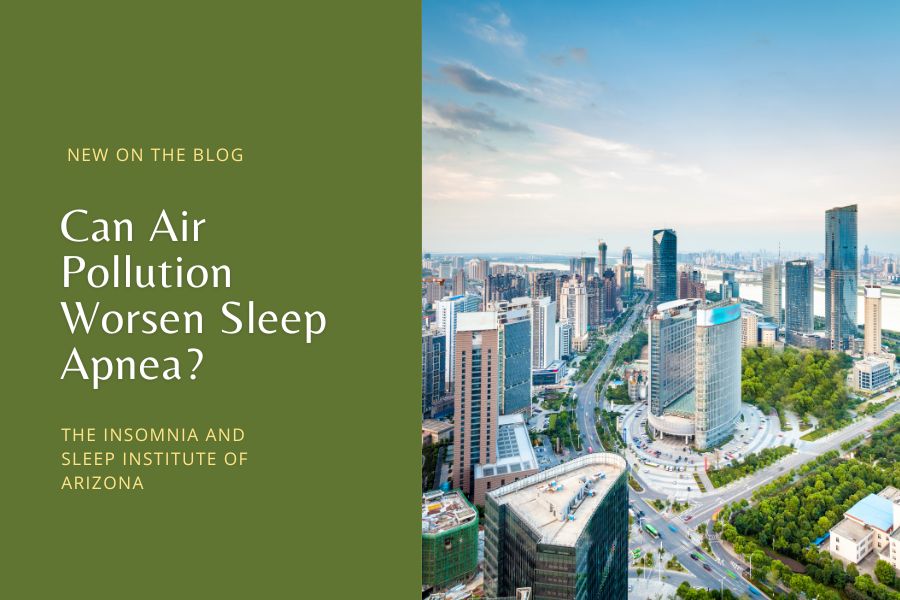Sleep apnea, a serious condition affecting millions, involves repeated interruptions in breathing during sleep. Left untreated can lead to severe health issues.
But could air pollution, a factor we often can’t control, be making it worse? Research suggests a strong link between air pollution and worsening sleep apnea symptoms.
What is Sleep Apnea and Why Should We Care About It?
Sleep apnea is a serious sleep disorder characterized by repeated interruptions in breathing during sleep. These interruptions, known as apneas, can last from a few seconds to over a minute. Disrupting the normal sleep cycle and reducing the quality of sleep.
There are two main types of sleep apnea. Obstructive Sleep Apnea (OSA) and Central Sleep Apnea (CSA). OSA, the more common type, occurs when the muscles in the throat relax excessively, leading to a blockage of the airway. CSA, on the other hand happens when the brain fails to send the correct signals to the muscles that control breathing.
The Impact of Sleep Apnea on Health
Sleep apnea is more than just a sleep disorder. It’s a significant health concern. Individuals with untreated sleep apnea face an increased risk of developing several chronic conditions.
For instance research shows that up to 50% of people with sleep apnea also have high blood pressure, a condition that can lead to heart disease and stroke. Additionally, sleep apnea has been linked to a higher risk of type 2 diabetes, depression, and even motor vehicle accidents due to excessive daytime sleepiness.
The prevalence of sleep apnea is alarming. According to the American Academy of Sleep Medicine, approximately 25 million adults in the United States are affected by OSA. Unfortunately, many cases remain undiagnosed. Leaving millions at risk of severe health complications.
Why Should We Care?
The implications of untreated sleep apnea extend beyond individual health. Sleep apnea can lead to significant healthcare costs. Both for individuals and the healthcare system as a whole. The disorder is associated with higher rates of hospitalization. Also an increased use of healthcare services and a lower quality of life.
Moreover, sleep deprivation impact on productivity can have broader economic consequences. Addressing sleep apnea is important not only for improving individual health outcomes. But also for reducing healthcare costs and enhancing overall public health.
How Does Air Pollution Affect Our Health?
Air pollution is a pervasive environmental issue that affects millions of people worldwide. It consists of harmful substances, including particulate matter (PM), nitrogen dioxide (NO2), and ozone (O3) that can penetrate deep into the lungs and even enter the bloodstream. These pollutants originate from various sources. Such as vehicle emissions, industrial activities and natural events like wildfires.
Health Effects of Air Pollution
The health effects of air pollution are profound and wide-ranging. According to the experts air pollution is responsible for approximately 7 million premature deaths each year.
It contributes to respiratory and cardiovascular diseases, including asthma, chronic obstructive pulmonary disease (COPD), heart attacks and strokes. Experts also links long-term exposure to air pollution with lung cancer and adverse pregnancy outcomes, such as low birth weight.
How Are Air Pollution and Sleep Apnea Connected?
The relationship between air pollution and sleep apnea has become a significant focus of research in recent years, driven by concerns about the pervasive effects of environmental pollutants on public health.
The findings from recent studies provide crucial insights into how air pollution may not only increase the risk of developing obstructive sleep apnea (OSA) but also exacerbate its severity. Here’s what the studies show:
The Link Between Air Pollution and Increased Risk of Sleep Apnea
One of the pivotal studies, a systematic review and meta-analysis, sought to consolidate existing data on the relationship between air pollution and OSA. The research focused primarily on two major pollutants. Particulate matter with a diameter of less than 2.5 micrometers (PM2.5) and nitrogen dioxide (NO2). These pollutants are common in urban areas, emitted from vehicles, industrial activities and other sources.
The meta-analysis included data from twelve studies, four of which provided quantitative assessments of air pollution’s impact on OSA. The findings were nuanced. Exposure to PM2.5 showed a pooled odds ratio (OR) of 0.987, indicating no substantial overall impact on OSA risk.
However, exposure to NO2, a common urban pollutant, was linked to a slightly higher risk of developing OSA, with a pooled OR of 1.095. Although these results did not reach statistical significance, they suggest a potential association between NO2 exposure and an increased risk of OSA, highlighting the need for further research to clarify this relationship.
Air Pollution and the Severity of Sleep Apnea
Beyond the risk of developing OSA, air pollution appears to worsening the severity of the condition. The same meta-analysis reported that many studies found a relationship between air pollution exposure and elevated Apnea-Hypopnea Index (AHI) levels. The AHI is a critical measure used to assess the severity of sleep apnea, with higher levels indicating more severe obstruction during sleep.
A study from the Multi-Ethnic Study of Atherosclerosis (MESA) further supports this finding. This research demonstrated that individuals with higher annual exposure to NO2 and PM2.5 had significantly greater odds of experiencing sleep apnea. Specifically, a 10 ppb increase in annual NO2 exposure was associated with a 39% greater adjusted odds of sleep apnea.
Similarly, a 5 μg/m3 increase in annual PM2.5 exposure was linked to a 60% greater odds of sleep apnea. These results underscore the potential impact of long-term exposure to air pollution on the severity of OSA. Suggesting that environmental factors are crucial in the development and progression of sleep disorders.
The Role of Air Pollution in Altering Body Water Distribution and Aggravating OSA
A third study explored a more complex mechanism linking air pollution to OSA severity. This research conducted in Taiwan, investigated how air pollution might affect body water distribution, potentially exacerbating OSA manifestations.
The study found that short-term exposure to PM2.5 and PM10 was significantly associated with changes in body water distribution. Particularly the ratio of intracellular-to-extracellular water. These changes, in turn were linked to increased OSA severity, as measured by sleep-disordered breathing indices and respiratory event duration.
The study suggests that air pollution could aggravate OSA through its effects on body water distribution. This finding adds a new dimension to our understanding of how environmental factors like air pollution might worsen sleep apnea, highlighting the need for strategies to mitigate pollution exposure to improve OSA outcomes .
The recent studies provide compelling evidence that air pollution is not just a general health concern but also a significant factor in the risk and severity of sleep apnea.
While the evidence is not yet definitive, especially concerning the specific impact of different pollutants. These findings underscore the importance of considering environmental factors in the management of OSA. Given the potential public health implications more research is needed to fully understand these connections. And to develop strategies to protect vulnerable populations from the dual threats of air pollution and sleep apnea.
What Can Be Done to Mitigate the Impact of Air Pollution on Sleep Apnea?
Air pollution is a growing concern. Particularly for individuals with sleep disorders like Obstructive Sleep Apnea (OSA). Reducing the impact of air pollution on sleep apnea requires a combination of personal actions and broader public health measures. Here’s how you can protect yourself and minimize the risks:
Personal Actions
One of the most effective ways to reduce exposure to air pollution is by improving indoor air quality. Since most people spend a significant amount of time indoors. Particularly during sleep, this can make a substantial difference in managing OSA symptoms.
- Air Purifiers: Using high-efficiency particulate air (HEPA) purifiers can help remove harmful particles from the air inside your home. HEPA filters can capture particles as small as 0.3 microns. Which includes pollutants like PM2.5. Using an air purifier can reduce the levels of indoor air pollution, providing a cleaner breathing environment, especially during sleep.
- Proper Ventilation: Ensuring that your home is well-ventilated can also help. However it’s important to be mindful of outdoor air quality. On days when air pollution levels are high, it’s better to keep windows and doors closed to prevent pollutants from entering your home.
- Avoid Indoor Pollutants: Reducing the use of indoor pollutants like tobacco smoke, certain cleaning products and candles can also improve air quality. These can contribute to poor indoor air conditions. Exacerbating OSA symptoms.
Monitoring and Responding to Outdoor Air Quality
Being aware of outdoor air quality and taking appropriate actions can further mitigate the impact of air pollution on sleep apnea.
- Air Quality Index (AQI): Regularly check the AQI, which provides real-time data on air pollution levels in your area. When AQI levels are high limit outdoor activities, especially exercise, which can increase exposure to pollutants.
- Face Masks: On days with poor air quality consider wearing a mask designed to filter out pollutants, particularly if you need to be outside. Masks with N95 or N99 ratings are effective at filtering out airborne particles, reducing inhalation of harmful pollutants.
- Green Spaces: Spending time in green spaces with lower pollution levels can help. Trees and plants naturally filter the air, creating pockets of cleaner air even in urban environments. Incorporating plants into your living space can also contribute to better indoor air quality.
Advocacy and Public Health Measures
Beyond individual actions, advocating for and supporting public health measures can create a broader impact.
- Policy Advocacy: Support policies aimed at reducing emissions and improving air quality. This includes regulations on industrial emissions, vehicle exhaust, and the promotion of cleaner energy sources.
- Community Initiatives: Participating in or supporting community efforts to plant trees, create green spaces and reduce local pollution sources can contribute to better air quality in your area. Benefiting everyone, especially those with conditions like OSA.
Note: The information provided is for general guidance and should not replace professional medical consultation. Always seek advice from a qualified healthcare provider.
How Can The Insomnia and Sleep Institute of Arizona Help?
The Insomnia and Sleep Institute of Arizona is dedicated to providing comprehensive care for individuals with sleep disorders, including OSA. Our team know the complexities of sleep apnea and its relationship with environmental factors like air pollution.
So we offer personalized treatment plans that consider your specific needs. With state-of-the-art diagnostic tools and a focus on holistic care we can help you manage your OSA effectively. Securing better sleep and overall health despite the challenges posed by air pollution. Contact us.
References:
Billings, M. E., Gold, D., Szpiro, A., Aaron, C. P., Jorgensen, N., Gassett, A., Leary, P. J., Kaufman, J. D., & Redline, S. R. (2018). The Association of Ambient Air Pollution with Sleep Apnea: The Multi-Ethnic Study of Atherosclerosis. Annals of the American Thoracic Society. https://doi.org/10.1513/annalsats.201804-248oc
Kingshott, R. (2014, September 29). Rising prevalence of sleep apnea in U.S. threatens public health – American Academy of Sleep Medicine – Association for Sleep Clinicians and Researchers. American Academy of Sleep Medicine – Association for Sleep Clinicians and Researchers. https://aasm.org/rising-prevalence-of-sleep-apnea-in-u-s-threatens-public-health/
Tahani Alrahbeni, Jeetendra Kumar Gupta, Anas Alkhouri, Ladi Alik Kumar, Mahal, A., Khalid Al-Mugheed, Prakasini Satapathy, Neelima Kukreti, Mahalaqua Nazli Khatib, Shilpa Gaidhane, Gaidhane, A. M., Sarvesh Rustagi, Mohanty, D., & Bijaya Kumar Padhi. (2024). Association of Air Pollution with Risk and Severity of Obstructive Sleep Apnea: A Systematic Review and Meta-Analysis. NeuroToxicology, 102, 106–113. https://doi.org/10.1016/j.neuro.2024.04.005
World must band together to combat air pollution, which kills 7 million a year. UNEP. https://www.unep.org/news-and-stories/story/world-must-band-together-combat-air-pollution-which-kills-7-million-year
Tsai, C.-Y., Huang, H.-T., Liu, M., Cheng, W.-H., Hsu, W.-H., Kuan, Y.-C., Majumdar, A., Lee, K.-Y., Feng, P.-H., Tseng, C.-H., Chen, K.-Y., Kang, J.-H., Lee, H.-C., Wu, C.-J., & Liu, W.-T. (2023). Associations between air pollution, intracellular-to-extracellular water distribution, and obstructive sleep apnea manifestations. Frontiers in Public Health, 11. https://doi.org/10.3389/fpubh.2023.1175203





